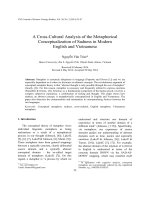the cultural construction of gender and representation of ide
Bạn đang xem bản rút gọn của tài liệu. Xem và tải ngay bản đầy đủ của tài liệu tại đây (35.8 KB, 4 trang )
Soaps but more importantly music videos can be said to interrogate the
cultural construction of gender and representations of identity. The video
suggests a set of images to the viewer and usually these are a blurring of
gender and identity. Music videos predicate on the representation of
female gender experience. The two interrelated sign systems- access
signs and discovery signs- will be discussed. Music clips that will be
focused on are Madonna's 'Burning Up', 'Express Yourself', and 'Justify
My Love'. The singer, who has been labelled 'Our Lady of MTV', has an
amazing video appeal due to her play with gender and identity. No other
single artist has produced as many mixed images as she has. Television
soaps tend not to interrogate the construction of gender and the
representation of identity. They do not seem to cross any boundaries.
People watch soaps to relax and somehow relate, so if they were to
experiment with the theatre of gender, it may be seen as a threat to
viewers. Soapies usually have the males in typically male dominated
occupations such as doctors, car salesmen and chefs. Women in soaps
are usually secretaries or housewives. There does not seem to be any
attempt for a switch of roles. Females are feminine, males masculine.
There has been one exception, which was Kylie Minogue's character,
Charlene, on Neighbours. She was a mechanic and tomboy. This is one
of the few occasions where a soap has interrogated the cultural
construction of gender and representation of identity. A music video is
footage that accompanies a song. They can have a storyline related to
the song, displays of images or simply focusing on the artist/s performing.
Music video is forever crossing the lines of gender and identity. It is able
to do this as it is seen as a form of art, therefore there is no threat to
viewers. It is ironic that Boy George has said that "video was the worst
thing to happen to music", when he himself looked and acted like he was
crossing the lines of gender and boundaries back in the 1980's.
Madonna is most famous for creating videos with no boundaries for
gender or identity. Most of the time, she deliberately plays with surfaces
and masks. Madonna visual style engages and hyperbolises the
discourse of femininity- she has bleached hair with dark roots, street
smart image yet glamorous. Gender play is the mix and match of styles
that flirt with the signifiers of sexual difference, and Madonna is always
doing that. The three music videos of Madonna to be analysed are
'Burning Up', 'Express Yourself', and 'Justify My Love'.Pouring money into
the visuals, she is the first female artist to fully exploit video. In the three
videos to be discussed, there is a mixture of suggestion and aggression.
'Burning Up' involves her and a man. She is writhing in the middle of the
road while he is driving towards her. At the moment where she seemed
submissive, she was actually about to take over- suddenly he
disappeared and at the end of the clip she was behind the wheel. It was
like she was powerless, but then she turns that image upside down by
showing who had the control.'Express Yourself' is very similar. It shows
her as being powerful and also as being weak. She plays with gender
through her wearing of a pin-striped suit ( the male sign of power and
success) and her crotch grabs. It also shows her with a chain around her
neck. Madonna says: "It's just an image I thought was powerful It
showed an extreme. Extreme images of women: one is in charge, in
control, dominating; the other is chained to a bed "It is evident in this
video that she interrogates the cultural construction of gender and
representations of identity."Justify My Love" is the same. The banned
video showed how gender roles could be swapped, blurred and played
with to create different identities. It showed men who looked and acted
like women and women who looked and acted like men. It totally
changed the typical gender roles and behaviour around.E. Ann Kaplan
(1897) stated "Madonna's feminism is part of a larger post-modernism
phenomenon which her videos also embody in their blurring of sacrosanct
boundaries and polarities such as male/female, high art/pop art, film/TV,
fiction/reality and private/public.Two interrelated sign systems developed
from videos predicated on female gender experience- access signs and
discovery signs. These can both be seen in Cyndi Lauper's 1983 hit
"Girls Just Want to Have Fun" and Madonna's 1984 song "Borderline".
Both are set in the street not feeling threatened, which is the access sign.
The discovery sign is being female. In 'Borderline" it is the fact she gets
discovered to be a model.Soaps but more importantly music videos can
be said to interrogate the cultural construction of gender and
representations of identity. The video suggests a set of images to the
viewer and usually these are a blurring of gender and identity. Music
videos predicate on the representation of female gender experience. The
two interrelated sign systems- access signs and discovery signs- will be
discussed. Music clips that will be focused on are Madonna's 'Burning
Up', 'Express Yourself', and 'Justify My Love'. The singer, who has been
labelled 'Our Lady of MTV', has an amazing video appeal due to her play
with gender and identity. No other single artist has produced as many
mixed images as she has. Television soaps tend not to interrogate the
construction of gender and the representation of identity. They do not
seem to cross any boundaries. People watch soaps to relax and
somehow relate, so if they were to experiment with the theatre of gender,
it may be seen as a threat to viewers. Soapies usually have the males in
typically male dominated occupations such as doctors, car salesmen and
chefs. Women in soaps are usually secretaries or housewives. There
does not seem to be any attempt for a switch of roles. Females are
feminine, males masculine. There has been one exception, which was
Kylie Minogue's character, Charlene, on Neighbours. She was a
mechanic and tomboy. This is one of the few occasions where a soap
has interrogated the cultural construction of gender and representation of
identity. A music video is footage that accompanies a song. They can
have a storyline related to the song, displays of images or simply focusing
on the artist/s performing. Music video is forever crossing the lines of
gender and identity. It is able to do this as it is seen as a form of art,
therefore there is no threat to viewers. It is ironic that Boy George has
said that "video was the worst thing to happen to music", when he himself
looked and acted like he was crossing the lines of gender and boundaries
back in the 1980's. Madonna is most famous for creating videos with no
boundaries for gender or identity. Most of the time, she deliberately plays
with surfaces and masks. Madonna visual style engages and
hyperbolises the discourse of femininity- she has bleached hair with dark
roots, street smart image yet glamorous. Gender play is the mix and
match of styles that flirt with the signifiers of sexual difference, and
Madonna is always doing that. The three music videos of Madonna to be
analysed are 'Burning Up', 'Express Yourself', and 'Justify My
Love'.Pouring money into the visuals, she is the first female artist to fully
exploit video. In the three videos to be discussed, there is a mixture of
suggestion and aggression. 'Burning Up' involves her and a man. She is
writhing in the middle of the road while he is driving towards her. At the
moment where she seemed submissive, she was actually about to take
over- suddenly he disappeared and at the end of the clip she was behind
the wheel. It was like she was powerless, but then she turns that image
upside down by showing who had the control.'Express Yourself' is very
similar. It shows her as being powerful and also as being weak. She
plays with gender through her wearing of a pin-striped suit ( the male sign
of power and success) and her crotch grabs. It also shows her with a
chain around her neck. Madonna says: "It's just an image I thought was
powerful It showed an extreme. Extreme images of women: one is in
charge, in control, dominating; the other is chained to a bed "It is evident
in this video that she interrogates the cultural construction of gender and
representations of identity."Justify My Love" is the same. The banned
video showed how gender roles could be swapped, blurred and played
with to create different identities. It showed men who looked and acted
like women and women who looked and acted like men. It totally
changed the typical gender roles and behaviour around.E. Ann Kaplan
(1897) stated "Madonna's feminism is part of a larger post-modernism
phenomenon which her videos also embody in their blurring of sacrosanct
boundaries and polarities such as male/female, high art/pop art, film/TV,
fiction/reality and private/public.Two interrelated sign systems developed
from videos predicated on female gender experience- access signs and
discovery signs. These can both be seen in Cyndi Lauper's 1983 hit
"Girls Just Want to Have Fun" and Madonna's 1984 song "Borderline".
Both are set in the street not feeling threatened, which is the access sign.
The discovery sign is being female. In 'Borderline" it is the fact she gets
discovered to be a model.It is important to see a music video as well as
hearing a song, because the video can change and correct any perceived
ideas. This is the case for "Material Girl". The song was telling of money
and acquisition, many thinking of Madonna as being money-hungry and
greedy. The video itself showed that it was one big parody on the idea
that diamonds are a girl's best friend, showing Madonna to like simpler
things instead. Her music videos are not to be taken seriously. She
simply produces images that may not be seen often. She was quoted as
saying " I play a lot of characters and everytime I do a video or a song,
people go 'Oh, that's what she's like'. And I'm not like any of them. I'm all
of them. I'm none of them".This shows that you cannot learn about her
as a person from her videos. They are merely to view rare images of
power and weakness at the same time. There are many music videos
that do not challenge gender or indentity. Such video clips as George
Michael's "Freedom". It seems slightly hypercritical that the song is about
being your own person and being strong, when the images portrayed
were supermodels looking like sex objects. Another video was Robert
Palmer's "Simply Irressistable", where the women were all dressed the
same with no expression, looking once again like sex obejects. Motley
Crue also did this in their clip "Girls, Girls, Girls". Though not suprising for
this band, it features females in bikinis acting like 'bimbos'. In these clips
there is no attempt to challenge gender or identities. No experimenting
with the two ideas, making the music videos pointless as they do not raise
any notions.From this essay, it is evident to see how music video can play
with the idea of gender and identity. Soaps do not do it as much as
music video. Music videos are always pushing the limits on how far they
can cross over into each one. Madonna is famous for





![the symbolic construction of community [electronic resource]](https://media.store123doc.com/images/document/14/y/te/medium_tew1401476448.jpg)



